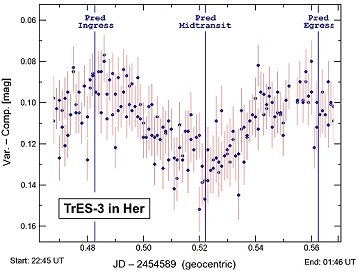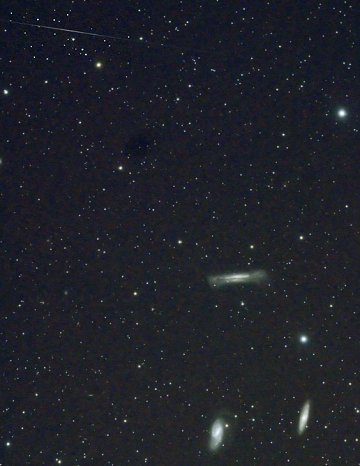| MOTHER'S DAY: Give your mom a truly heavenly gift on May 11th--a subscription to Space Weather PHONE! | | | MOON & MARS: Do you know where Mars is? Let the Moon be your guide. Tonight the crescent Moon is passing by the twins of Gemini and making a beeline for the red planet. You can't miss it. Look west after sunset for a heavenly orientation: sky map. DOOMED PLANET TRANSIT: About 1300 light years from Earth, in the constellation Hercules, a planet named TrES-3 twice as massive as Jupiter is slowly spiraling into its parent star. It orbits so close to the star, in fact, that it occasionally passes in front and dims the starlight--a telltale fluctuation that led to its discovery by astronomers in May 2007. On May 3rd, 2008, Anthony Ayiomamitis observed a transit of TrES-3 from Greece "using only a 6.3-inch apochromatic refractor," he says. "I am delighted to present you with a light curve, which most beautifully illustrates the 105-minute event." 
"At some point," he notes, "this exoplanet will not be available for study due to its impending collision into its sun. One can only wonder and dream how sunrises and sunsets will appear on this foreign world, if at all, and whether it has moons similar to Luna dominating the night sky with breath-taking eclipses and lunar phases, and if its atmosphere is a playground of light including auroras, NLCs and meteor showers." "What makes photometry of this exoplanet most challenging," he adds, "is the fact that its parent star is dim at magnitude 12.17 and the planet makes only very small changes in the overall brightness, from 12.170 to 12.195." Click here to learn the details of these skillful measurements. RANDOM METEOR: Last week in the Black Forest of Germany, Achim Schaller was testing his new Nikon D300 by attaching it to his backyard telescope and taking a few pictures of the Leo Triplet of galaxies. "When I looked over the images," he says, "I found one of them had caught a meteor in flight." There was no meteor shower in progress on April 29th when Schaller took the picture. So where did the meteor come from? Scroll down for the answer: 
It was a "sporadic" or random meteor. Every night, thousands of them flit across the sky mostly unseen because they are so dim. The one in Schaller's photo registered 10th magnitude, too faint by a factor of 40 to see with the human eye. (Note: Not all random meteors are faint. Standing under the stars on a dark, moonless night, you can count a few sporadics every hour plainly visible to the unaided eye. Most, however, require a telescope.) Random meteors come not from any particular comet or asteroid, but from a diffuse swarm of space dust that fills the inner solar system. "Every day Earth sweeps up about 22 metric tons of this material," says Bill Cooke of NASA's Meteoroid Environment Office. He estimates that "40% of that mass, or 8.8 metric tons, turns into meteors of 10th magnitude or brighter: graph." If those metric tons arrived in a single lump, the result would be a fantastic fireball in the sky and possibly a scattering of meteorites on the ground. Instead, the swept-up material arrives mainly as microscopic bits and pieces, producing a faint drizzle of year-round meteor activity. The meteoroid in Schaller's photo probably had a mass "of around 0.00005 grams," notes Cooke. Tiny, but beautiful!
April 2008 Aurora Gallery
[Aurora Alerts] [Night-sky Cameras] | 
